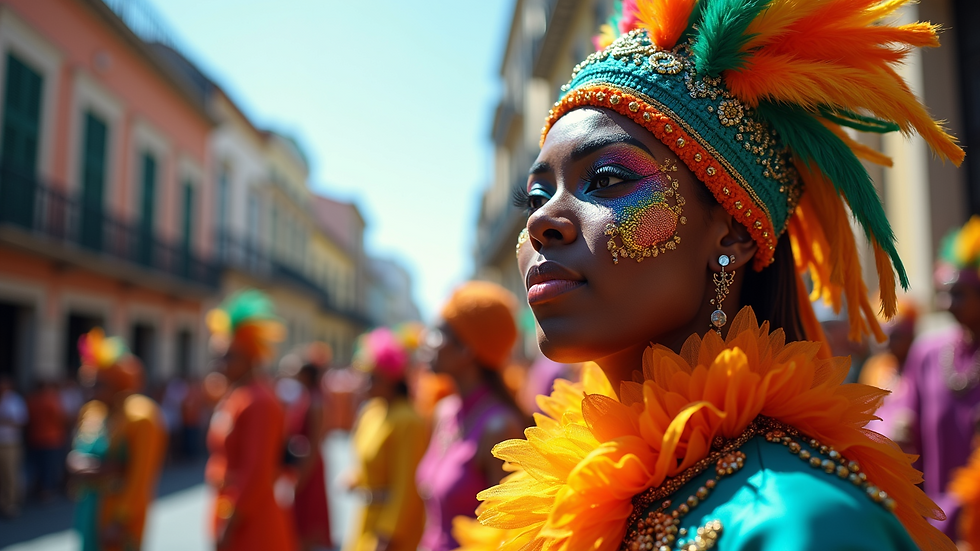From Pagan Bacchanalia to Christian Carnaval: Transformation of Spring Festivals through the Ages
- koadofthecrossroad
- Apr 5
- 3 min read
The vibrant celebrations of ancient cultures have had a lasting impact on how we celebrate today. One of the most significant transformations is seen in the festivals dedicated to Bacchus and his counterpart Dionysus. Originally, these festivals marked the arrival of spring, celebrating life and growth. However, as societies evolved, so did the meanings and practices around these ancient festivities. This article explores how the Bacchanalian celebrations, deeply rooted in pagan traditions, transitioned into the Christian celebrations of Carnaval and Lent. Along the way, we will discover the rituals and beliefs that have reshaped these festivals across the ages.
The Bacchanalian Roots
In ancient Rome, the festivals honoring Bacchus, the god of wine and fertility, were filled with exuberance. The festivities typically kicked off in late March and included elaborate parades, music, and uninhibited dancing. Historical accounts suggest that during these Bacchanalian events, revelers would consume vast amounts of wine. It's estimated that people consumed around 5 gallons of wine per person over the course of the celebrations, showcasing both abundance and excess.
Participants often ignored social norms and daily routines, engaging in unabashed merrymaking that drew mixed reactions from society. Some viewed these gatherings as essential expressions of communal joy and divine connection, while others criticized them for promoting moral decay. After the celebrations, participants would undergo a period of abstinence. This time was seen as necessary for recovery, allowing them to cleanse both body and spirit as they prepared for the rebirth associated with spring.
The Roman Government's Intervention
By 186 BCE, the Roman government saw the potential dangers of such unrestrained festivities. Concerned about family values and societal stability, they implemented laws to limit Bacchanalian practices. This crackdown led to a gradual transformation of the Festival of Bacchus. For instance, the number of allowed celebrations decreased, and strict moral conduct was enforced.
As a result, Bacchanalian traditions began to evolve into more structured events. Elements of celebration were preserved, but they now had a religious overlay that aligned more closely with emerging Christian values, paving the way for what we recognize today as Carnaval.
Transition to Christianity
By the sixth century A.D., the Bacchanalian celebrations began merging with Christian principles, ensuring their survival. The single day of raucous festivities transformed into a longer period of reflection leading up to Lent. This shift marked a move toward a more structured celebration. The original focus on indulgence gave way to a period of kindness and community, symbolized by a vegetarian diet for a lunar cycle and a focus on family gatherings.
In this new framework, new activities emerged. People began flying kites honoring Zeus during the spring winds, a custom that symbolizes hope and joy, while honoring the agricultural aspects of nature reflected in the traditions of Demeter, the goddess of harvest.
The Formalization of Carnaval and Lent
The transformation of Bacchanalian rites continued as they were woven into Christian culture. Carnaval became fixed to certain dates, often occurring before Lent begins. Rather than indulgence, these days were now a precursor to a more somber time of fasting and reflection known as Lent.
This shift highlighted a transition in themes—from Bacchus as the liberator of earthly pleasures to a focus on spiritual cleansing, which mirrored Jesus' 40 days of fasting in the desert. The vibrant celebrations morphed into a season of introspection, during which communities prepared their bodies and souls for significant spiritual observances, like Easter.
Cultural Significance and Modern Celebrations
The legacy of transformation between the Bacchanalian festivals and modern Carnaval illustrates a rich cultural dialogue. Today, Carnaval maintains echoes of its past. Festivities around the world, from Rio de Janeiro’s Samba parades to the colorful floats in Venice, showcase the vibrancy and joy that harks back to Bacchus's original celebrations.
Even during the fasting of Lent, Carnaval remains a pivotal time for joy. It serves as a reminder of the importance of community and togetherness, even in times of austerity. Celebrations emphasize that while reflection is vital, joy and connection are equally important.

The Journey of Transformation
The evolution from Bacchanalian festivals to the Carnaval we know today is a captivating journey that spans centuries. This metamorphosis reveals humanity's capacity to adapt and reinterpret cultural practices while bridging religious gaps. Both Bacchus’s lively feasts and Christian traditions remind us that life is about celebrating moments, both joyful and reflective.
As we partake in Carnaval or observe Lent, let us honor this rich legacy. Each celebration serves as a chance to rejuvenate and connect us with a timeless rhythm that dances through history. Embracing both joy and contemplation enriches our shared human experience, weaving a vibrant tapestry of culture and spirituality that continues to thrive today.



Comments